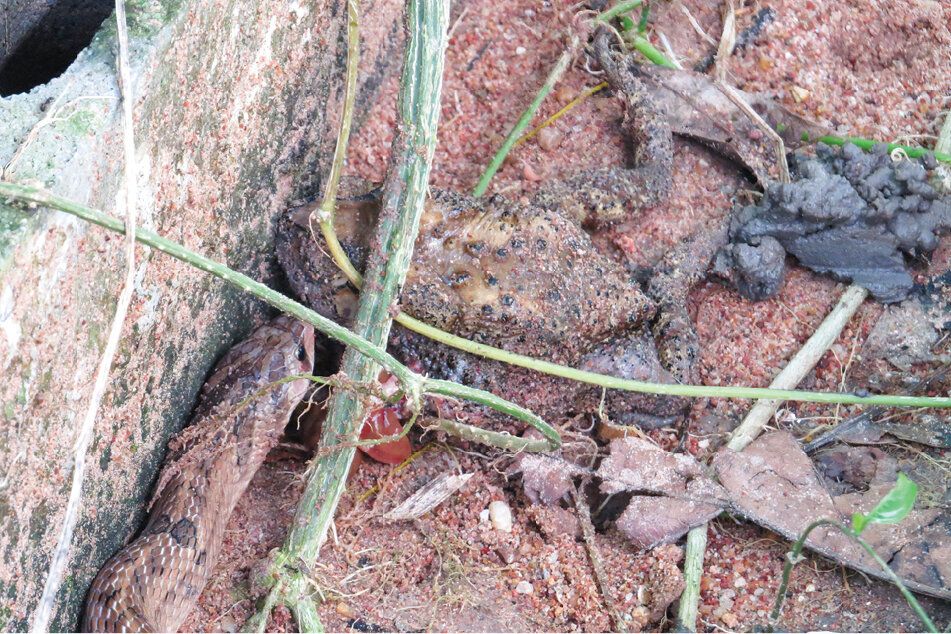This Snake Slurps Organs of Living Toads in Grisly Feeding Strategy
Researchers say no other snakes are known to feed this way, adding that the snakes may feed this way to avoid toxins secreted from the toads’ backs
:focal(425x294:426x295)/https://tf-cmsv2-smithsonianmag-media.s3.amazonaws.com/filer/16/94/169487f4-4123-48a2-a66e-4dff4a903c77/snakesdisemb_1.jpg)
In 2016, herpetologists studying snakes in Thailand witnessed something they’d never seen before. They came upon a snake that had killed a large poisonous toad, and were shocked by what happened next.
The snake, a small-banded kukri (Oligodon fasciolatus), used a set of enlarged, curved teeth at the back of its jaws to make a slice the left side of the toad’s belly. The snake’s head swung from side to side as it made the incision, and then, slowly, plunged entirely inside the toad’s body and pulled out the unfortunate amphibian’s liver, heart, lung and stomach. According to new research published this month in the journal Herpetozoa, the snake then proceeded to eat the toad’s organs one by one.
Most snakes swallow their prey whole, and no other snakes are known to feed quite like the kukri snake, reports George Dvorsky for Gizmodo. Sometimes, especially unlucky toads are still alive when these serpents disembowel them, Henrik Bringsøe, an amateur herpetologist from Denmark and the first author of the new study, writes in a statement.

Kukri snakes are usually under three feet in length and are named for a distinctive recurved machete historically wielded by the Nepali speaking Gurkha soldiers from Nepal and parts of India. Kukri blades are known for their ability to easily make deep slashes as tools or weapons, and the new research finds the snakes that bear the blade’s name use their sharp, curved teeth to similar effect. In addition to their lacerating teeth, the kukri snakes possess glands that secrete anticoagulants, encouraging the sliced toad to bleed freely during the snake’s almost surgical feeding process that the paper says can last hours, “depending on the organs the snake would pull out first.”
The researchers speculate that the kukri snake’s ghoulish table manners may have come about as a way to avoid the toxic secretions of the toads they prey on. In all three observations of the snake’s grisly feeding behavior, the Asian common toad (Duttaphrynus melanostictus), which oozes a potent milky poison from glands on its back and neck, was the victim.
In a fourth instance, the snake took a more traditional tack and swallowed the toad whole, reports Mindy Weisberger for Live Science. This toad was smaller and the researchers wonder if perhaps younger toads are less toxic or if the kukri snake has developed a resistance to its prey’s chemical defenses.
Alas, “at present, we cannot answer any of these questions, but we will continue to observe and report on these fascinating snakes in the hope that we will uncover further interesting aspects of their biology,” writes Bringsøe in the statement.
The researchers assure that kukri snakes pose no real danger to humans, but advise against being bitten by one: “They can inflict large wounds that bleed for hours, because of the anticoagulant agent these snakes inject into the victim’s bloodstream,” writes Bringsøe. “Their teeth are designed to inflict lacerations rather than punctures, so your finger would feel as if cut apart!”
/https://tf-cmsv2-smithsonianmag-media.s3.amazonaws.com/accounts/headshot/alex.png)
/https://tf-cmsv2-smithsonianmag-media.s3.amazonaws.com/accounts/headshot/alex.png)